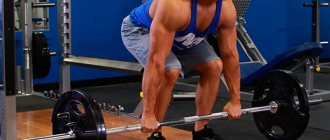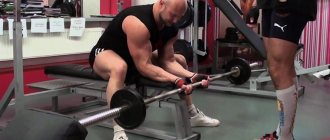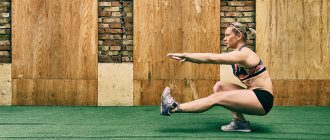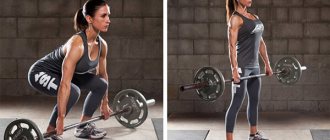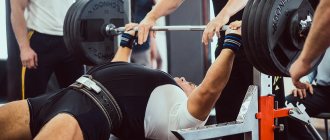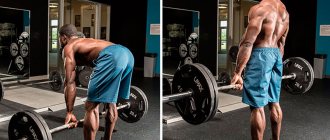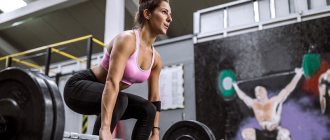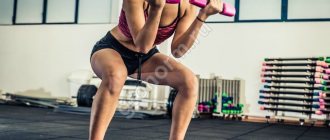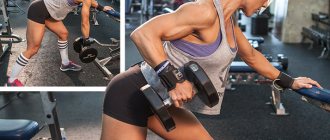Why is the squat called the king of exercises?
We have already noted that the exercise is considered basic due to the fact that several muscle groups are involved in the work. Squats are a heavy lifting exercise that uses free weights. Testosterone is intensely released into the blood (especially during critical loads on the body) - this is the reason for the increase in weight. In total, about 250 muscles are involved in the exercise. Let's list the main ones:
- quadriceps femoris;
- gluteal (large, medium and small);
- back;
- back of the thigh;
- leg muscles;
- abdominal planks.
On a note! By the way, about the legs. The exercise allows you to strengthen the tibialis anterior, peroneal, gastrocnemius and soleus muscle groups. Experienced trainers will tell you about stabilizing the lower back and back. Of course, with proper technology.
Squat technique
Without long introductions. Basic questions about squats:
— Positioning of the feet (wider, narrower, shoulder-width apart);
— Reversal of feet (has anyone even thought about this?);
— Emphasis on the heels/toes (which is correct?);
— Squat depth (the most controversial issue);
— Position of the knees (can the knees go beyond the toes?)
— Bend in the lower back (“butt wink” or when “the butt bites”);
- and a couple more nuances.)
- Positioning the legs.
The standard position of the legs when squatting is shoulder-width apart (1), or slightly wider (2). There is a dependence on height; as a rule, the taller the person, the wider the legs need to be placed in order to minimize the unwanted movement of the knees forward (beyond the toes) when squatting.
If we start from muscle work, then:
- with a wide stance: the back of the thigh, gluteal muscles, and inner thigh work more.
Separately about quadriceps. They also work with a wide stance, but the wider we place our legs and the more we turn our feet outward, the more the load shifts to the muscles of the inner thigh.
- with a narrow stance of the legs , the quadriceps is loaded more.
Bottom line: if you want to work the gluteal and inner thigh muscles, use a wide stance. If you want to work your quadriceps and outer thighs, use a narrow foot stance.
- Stop reversal.
Everything is simple here, the wider the position of the legs, the more you need to turn your feet outward. Why? When squats, the knees not be brought together with an X, otherwise this will lead to injury to the knee joint.
An example of an incorrect, “X-shaped” knee position when squatting/running:
- Emphasis on the heels.
One of the indicators that your technique and foot placement is correct is when the weight of the body/barbell presses on the heels and on the outer edge of the foot. If the weight presses on the toes, then a dangerous load is created on the knees. In this case, you need to adjust the weight of the barbell, the position of your legs, the tilt of your body, and perhaps change your shoes to more comfortable ones (flat-soled shoes are good for squats).
- Bend in the lower back.
When squatting, it is important to maintain a slight curve in the lumbar region. In this way, we transfer the load from the back to the gluteal muscles, forcing them to work as an extensor of the body.
Another point that is quite common during a “deep” squat is the tuck of the pelvis (“butt wink” or when the butt “pecks”).
Pelvic inversion may be associated with poor flexibility, tightness of the hip muscles, etc. This is a fairly common phenomenon, and in general it is not so terrible if the pelvis tucks in a little, but the back remains straight . But if the back is rounded, the load on the spine increases significantly, which can ultimately lead to injury.
Therefore, the main advice is not to lose the curve in the lower back when squatting. Sometimes it is better not to squat too deeply in order to maintain a natural curve, so as not to “drop your pelvis”.
- Squat depth.
This is the most controversial issue. And here I would recommend starting from your goals. If you are a professional athlete, then you probably have no choice, because... this moment is strictly regulated. But if you work out in the gym for yourself, then the depth of the squat should be determined by your technique . That is, if you can squat “deeply” and at the same time maintain the correct technique (head looks forward, straight back, pelvis does not peck, knees do not come together, emphasis on the heels), then great, a deep squat is completely suitable for you. But if your technique deteriorates with a deep squat, then it is better to abandon it.
What are the benefits of deep squats? Greater range of motion, more load on the muscles, and therefore better growth. But on the other hand, you can take more weight, reduce the range of motion (for example, squat until parallel to the floor) and still get the same load on the muscles. So, I repeat once again - the main thing is that the depth of the squat does not worsen your technique.
Perhaps the ideal option is a deep squat, with good technique (we sit down by moving the pelvis back, the torso is not tilted forward too much, we do not place the chest on the knees, the back is straight) and correctly selected weight (the maximum weight at which you still maintain the correct technique , and strain and stretch the gluteal muscles as much as possible). But this is ideal.)
An example of two correct variations of a deep squat:
- Knee position (can knees extend beyond toes?)
The general rule is “ when squats, your knees should not go beyond your toes .” If you are taller than average, you will need to place your feet a little wider to minimize unwanted knee padding/pushing forward (beyond your toes) when squatting.
The exception is deep squats (butt to heels). When doing a deep squat, your knees MUST extend beyond your toes, otherwise you'll end up arching your back, which is much more dangerous.
An example of when your knees MUST extend beyond your toes:
Once again I will return to the rule - “when squats, the knees should not go beyond the toes.” First of all, it is relevant for beginners, because... when we control our knees, the pelvis automatically moves back, the weight is transferred from the toe to the heel - this is exactly what is needed. Therefore, it is easier for a coach to say once, “watch your knees,” than to explain all the nuances (this is where the rule about knees came from; if you want, you can call it a myth). Remember that first of all you need to keep a straight back, your knees can go beyond your toes and in some cases must go out, otherwise you will not stand up with a straight back.
- Bringing your knees together when lifting.
A fairly common mistake in squats is bringing the knees together when lifting with an X. This can be due to incorrect positioning of the legs, if we do not point our toes out far enough, and it may also indicate insufficient development of the inner surface of the thigh. The wider the position of the legs, the greater the load on the inner thigh. If the muscles are weak, then the body transfers the load to the quadriceps, bringing the knees together with the X.
Once again I will return the picture with the “X-shaped” position of the knees when squatting/running:
The advice here is simple, experiment with positioning your legs, take lighter weights, develop your inner thighs (to help - squats with wide legs, side lunges).
- Smith machine and hack machine squats.
Very often, trainers in the gym put beginners to squat in a Smith or Hack machine. Firstly , it’s easier to install the equipment this way, and secondly, there ’s less need to explain.
But there are also negative aspects. Some call the Smith machine and the Hack machine a conveyor belt for “killing” the knees. When we squat in a hack machine (or in a Smith machine), the knees are pushed forward strongly, dropping below 90 degrees, the femur tends to move forward relative to the shin bones (and only the ligaments that prevent the femur from finally moving out of the joint). The second point is that when we squat in Smith and place our feet far forward from the bar, our back is in a very vulnerable position. Therefore, in general, general recommendations for these simulators are partial amplitude (in which even natural movement is close to a straight line), small weights and use the simulators at the beginning of the journey, or later for warming up.
If you are not a beginner, then I recommend moving away from squats in Smith:
Still, free weights are better, as they allow you to move along the path that is most natural for your body.
PS
And further…
— If you feel discomfort , especially pain (not muscle), then it’s better not to do it ;
— Squats also train the core muscles, and these include the abdominal muscles, so many people do not train the abs separately;
— When doing squats, intra-abdominal pressure increases (therefore, they are not recommended for pregnant women). If you cannot control your stomach when doing squats with heavy weights (your stomach should be pulled in), then wear a special belt;
— When squats, the bar should not lie on the neck , it should be lowered slightly to the shoulder blades.
— The most vulnerable position for the knees is a 90-degree angle at the knee joint. Squats to “parallel to the floor” are the most traumatic, since the entire load (stopping the weight, dead point) falls on a 90-degree angle in the knees (although many consider the most traumatic option to be a deep squat);
maximally load the gluteal muscles in squats, you need to make a more acute angle in the hip joint (see the picture below, the option on the left, by the way, pay attention to the correct position of the barbell on the back, and the position of the barbell relative to the feet);
— If the goal is to “round your butt,” then in addition to squats, there are a lot of effective exercises, which I examined in detail.
5 1 vote
Estimate
See also:
- Butt workout
- Strength gains are not linear.
- When glycogen runs out, does fat “burn”?
Why are back squats more popular than regular squats?
When it comes to barbell squats, their popularity is rapidly growing – especially when compared to regular squats. The reason lies on the surface - athletes want to quickly pump up their gluteal muscles. Weighting always leads to accelerated growth of muscle mass. Barbell squats have other advantages:
- Quadriceps receive maximum load.
- The calf muscles and thighs (back surface) are intensively pumped.
- “Explosive power” develops.
- Joints are strengthened.
- In terms of the number of muscles involved, squats can only be compared to deadlifts.
- The results of the set appear quite quickly.
High repetition squats[edit | edit code]
High rep squats
is a barbell squat method that features a high number of repetitions (an average of 20 per set). According to many authors, they cause a number of positive physiological reactions that are beneficial when practicing bodybuilding (growth, muscle definition) and powerlifting (strength, endurance). Often used to break a training plateau by experienced athletes, although it can be used in training programs for beginners. Gained popularity after the publication of Dr. Strossen's book in 1989, “Super Squats: How to Gain 30 Pounds of Muscle in 6 Weeks,” and was also actively used by Brooks Kubik. Faleev denies the usefulness of this method.
The main advantage is that the leg muscles (quadriceps) contain mainly slow-twitch muscle fibers, which require more repetitions to train and hypertrophy. The National Federation of Personal Trainers recommends 20-25 repetitions for muscles that contain predominantly this type of fiber.[1]
Moreover, there is an unconfirmed belief that deep, high-repetition squats allow you to expand the chest[2], and cause increased secretion of growth hormone, while you must follow a special deep breathing technique, which is described in the main article.
High-rep squats are often recommended during cutting and burning fat, as they allow you to burn the maximum amount of fat due to the greater volume of muscle cell work. At the same time, the number of mitochondria, the main consumers of fatty acid energy, increases significantly.
Scientific rationale[edit | edit code]
In 2004, a scientific paper was published in the Journal of Strength and Conditioning Research, in which scientists concluded that a combination of high-rep and low-rep exercises is more effective for muscle growth and strength, compared to using only one of these approaches.[3]
Example training program[edit | edit code]
Video example (according to Strossen) 1x20
Multi-Rep Squat Technique (Strossen): Take the weight you squat with 10 times (aim to reach 150% of your body weight) and squat with it 20 times. Due to the increase in weight, the duration of the exercise increases to 5 minutes due to long rests between repetitions. This completes the leg training; in the next workout, a 2.5 kg heavier weight is used. A long rest period between leg workouts is required for full recovery (3-7 days).
Strossen, in his book “Super Squats,” argues that the enormous stress that such a load puts on the body provides a powerful stimulus for growth in both mass and strength. During the exercise, you need to breathe deeply and intensely. After 10-15 repetitions, it no longer matters how many inhalations and exhalations you have to take to complete another repetition, the main thing is that it still takes place, and with the correct technique. With each repetition, the rest time increases. After training in squats in a similar manner for two to three months, you will be able to gain some experience, which will best tell you about the effectiveness of the proposed training method.
Here is an example of leg training (one day using a split program).
- Squats with a barbell 4x7,10,20,25
- Leg curls in the machine 3x15
- Standing calf raise 3x20
Or:
- Squats with a barbell 10x10 - rest between sets approximately 1 minute
Or:
- Squats with a barbell 1x20
- Leg press 3x6
- Leg curls in the machine 3x15
- Standing calf raise 3x20
Basic program for beginners[4]:
- Barbell squats: 1×20
- Pullovers: 1×20
- Deadlift: 1×15
- Pullovers: 1×20
- Bench Press: 2-3 x 10
- Bent-over barbell row (video): 2-3×15
- Military press: 2-3 x 12
In addition to doing 20 reps of squats, trainees are advised to follow an appropriate diet and get enough rest. Remember to progressively increase the weights with each new leg workout.
How deep should you squat?
Stopping flexion is, as you remember, one of the controversial issues.
Let's say goodbye to the myth about the dangers of full squats. A healthy person who has no contraindications in the hips, knees or spine is able to withstand this exercise without harming himself. You can squat a quarter, a half, or a full depth with ease, as Powers and Salem proved in 2002. The research results are published in J Orthop Sports Phys Ther (32nd issue) on pages 141-148. The only issue to consider is the vertical external load. We are talking about axial pressure and the position of the pelvis. Pressure on the spinal discs occurs in athletes who lift weights three times their own. But the pelvis at certain angles of inclination makes the spine round, which is also not good. Therefore, the limits of flexion are selected by the coach individually, taking into account the physical capabilities of the athlete.
Study “Effectiveness of using a belt for squats”
Let’s refer to the study “The Effectiveness of Using a Belt for Squats.”
For the study, experienced athletes were selected who could squat either with at least 1.6 of their body weight (i.e., with their own weight of 100 kg they could squat with at least a barbell of 160 kg), or with a barbell of at least 125.5 kg, at least for 8 reps.
However, during the study itself, many aspects of squats were measured: muscle activation, angles of inclination (to control for changes in technique), intra-abdominal pressure, exercise time.
In the study, athletes squatted their pre-measured 8-rep max without a belt. With this weight, the subjects first did squats with a belt and then without it.
And here are the results the scientists got.
Full deep squat or half squat – which has more advantages?
Squat depth is a subject of endless debate among athletes and coaches. The experiments carried out could not prove the statement that the risk of injury increases when performing full squats. Full squats do not affect performance as effectively as many previously thought. It turned out that the load on the knees when moving to half-squats is replaced by the load on the spine.
Important! In 2012, fitness trainer Bryanton finally proved that in squats, not only the load is important, but also the amplitude. Overload can significantly improve performance, but at the same time the risk of injury increases.
By increasing the depth, you tighten the knee extensors and reduce the use of the ankle extensors. The activity of the biceps and femoral muscles increases. By decreasing the depth, you strengthen the calf muscles and ankle extensors. But this only works when the bar is weighted. The choice is yours.
Exercise Variations
So, you bought an expander for squats, studied the features, and read the recommendations. It's time to start exercising! What variations are especially popular among modern athletes?
- Squats with crunches. The accessory is pulled between the feet, a squat is made, and while lifting, the knees are pulled alternately to the chest;
- Squats with elastic bands on knees. Classic execution technique;
- Squats with rubber bands under your feet. The athlete steps on the folded loop, holding one half with his hands so that during the rise the rubber is stretched, creating additional load;
- Jump squats, expander on knees;
- Squats with side lunges;
- Walking in single file;
- Squats with side swings;
- Jump-squat-side step;
- Side lunges with side swings;
Which is better: squats or lunges and why?
Let's make a reservation right away: both exercises are equally good for developing the lower body. You can squat with or without a barbell, with pancakes or dumbbells. In addition to pumping up your legs, you get the development of torso stabilizers. Fitness trainers note the following benefits of squats over lunges:
- The whole body is being worked on.
- The buttocks and quadriceps are loaded.
- Tendons and ligaments are strengthened.
- Metabolism accelerates.
- Help with weight loss.
- There are many options.
As for lunges, they pump up the same muscle groups, but at the same time focus on tendons and joints. Muscles can be pumped at any angle using weights. Functionality comes to the fore. There are other advantages :
- Stretching, balance and flexibility training.
- The spine is less stressed.
- The buttocks are tightened and made elastic.
- No special machines or barbells are needed.
This is interesting! Fitness instructor Alexandra Bonina recommends incorporating both exercises into your training program and does not give a clear preference to any technique. Lunges work the buttocks better, squats work the legs.
How to squat correctly with an elastic band on your legs?
If you're worried that you don't know how to squat properly with bands on your legs, relax. The accessory does not require any special technique; the most important thing is to know the correct algorithm for performing each exercise without an expander.
However, in order for the question “how to squat with an elastic band for fitness” to be finally resolved, read the following recommendations:
- Never skip the warm-up and cool-down - muscles and ligaments need to be warmed up and prepared for work;
- Breathe correctly - in squats, inhale always on the way down, exhale on the way up;
- Never exercise if you don't feel well;
- We recommend choosing an accessory with a non-slip surface to make it more convenient to exercise.
- Wear long, tight-fitting pants while exercising to avoid chafing and injury to the skin of your legs.
- Of course, use an expander with a level of rigidity that suits you;
- Never stop there - regularly increase the load.
Well, that's all, we told you about all the features of using a band for squats. Now your legs will become even slimmer and your body toned. Have fun with your training!
How many barbell squats should you do if you want to see results quickly?
You should always start with warm-up approaches. To begin, squat with an empty bar 8 times, then 5 times with half the working weight. Three more times – 75%, and one – up to 90% of the usual mass. Working with a weight of 80 kilograms? The program will look like this:
- empty bar – 8 times;
- 40 kilograms – 5;
- 60 kg – 3 times;
- 70 kg – 1 time.
On a note! Rest between sets during warm-up should not exceed half a minute. When you move on to working weights, the duration of pauses reaches one to two minutes.
Execution technique
Initial position
- The height of the racks is determined by the height of the athlete; the bar must be installed so that one can approach it and place it on the collarbones;
- Carefully place the barbell on your chest so that you can comfortably hold the weight;
- Grab the bar with an overhand grip, shoulder-width apart,
- By extending the knee and hip joints, remove the barbell from the racks;
- Step back with your leading leg, place your feet shoulder-width apart, heels under your shoulders;
- Raise your elbows so that the bar does not roll off your collarbones and your grip is strong;
- Bring your knees in, take a deep breath, tighten your abs, tighten your back, and get ready.
Movement
- By spreading your knees to the sides and bending the knee joint, lower your pelvis down and move, bending your legs at the knee and hip joints;
- Keep your back straight and knees apart throughout the entire path of movement;
- Lower your pelvis below your knees and stop the movement at the point of maximum muscle stretch;
- Extend the knee and hip joints to the starting position, keeping your back straight;
- Repeat the required number of times and complete the exercise.
Front Squat - Technique. Full analysis!
Attention
During the exercise, keep your back straight, try not to lean your elbows forward, and do not push out the anterior abdominal wall
How many times per week should you deadlift and squat?
A specific muscle group will grow continuously when performing 5-15 approaches weekly. Exceeding the limit does not make sense - you will not achieve better results. This works out to 1-3 sessions weekly, provided that the workout includes five approaches. Variations of the exercise should be alternated. Include in the program:
- back squats;
- the same with the bar on the chest;
- sumo;
- overhead.
conclusions
• If you have been passionate about strength sports for a long time, then it is difficult to increase the strength of your muscles and back at the same time; it is better to focus separately, first increasing the strength of your back and then your legs, or vice versa.
• If you have just started training, your legs will be weaker than your back, so pay special attention to them.
• It is not recommended to do squats in the absence of deadlifts or at least deadlifts, as well as deadlifts without squats, this will lead to a large difference in muscle strength. For example, by constantly increasing the weight in squats, the back also receives a powerful load, but its strength will remain in place with an ever-increasing load, this simply greatly increases the risk of lower back injury in the future.
The same applies to deadlifts, the weight is growing, and the legs are weak, either introduce 2 exercises into the workout or don’t do them at all.
• Finally, if you want to increase leg strength, do sumo-style deadlifts less often, as they heavily involve the glutes and inner legs, while squats focus on the outer quadriceps.
• If you are not going for record weights, do not perform squats and deadlifts below 4-5 repetitions, this is dangerous for your back and knees, no matter what anyone tells you, if you want to develop strength, this number of repetitions will be enough.
Can squats give you abs?
They can.
The abdominal planks develop in parallel with the back extensors. Your body works in harmony, which leads to improved coordination and an overall beautiful figure. So do squats and get your belly toned. Summarize . No matter what type of squats you do, your butt, abs, and thighs will be greatly strengthened. Are you involved in athletics or team sports? And here you can’t do without squats as an auxiliary workout. The main thing is to select the depth with the help of an experienced coach.
Proper shoes and clothing for squats
In conclusion, I would like to mention such an important aspect as shoes. The fact is that you can’t squat in just any shoe. The foot must be firmly fixed, so sneakers with soft soles will not work. The ideal solution would be to purchase weightlifting weights, but many may be put off by their cost. A more budget-friendly option would be to choose sneakers with a small heel and a solid, rigid sole. Under no circumstances should you squat in flip-flops! This is a serious mistake and can lead to injury!
The same applies to clothes. Pants or shorts should be elastic enough so as not to restrict movement. For maximum comfort, I recommend using tights or sweatpants. Squatting bare-chested is highly discouraged, and not just for ethical reasons. The thing is that you may sweat and the bar will start to slide down, so I recommend using a T-shirt with sleeves or a sweater.
Squat Rules
It is very important to perform the correct squat, since it determines how effectively the muscles will work and how quickly positive changes can be expected. So, here are some rules and recommendations for performing the exercise:
So, here are some rules and recommendations for performing the exercise:
In order for the squat to be correct, you cannot lower your pelvis below knee level. Breathe evenly and naturally. Tighten your muscles as you inhale and relax as you exhale. Lower and rise without jerking. The main thing is not the number of times, but their quality. When moving down, the hip joint should bend first, and then the knee. Keep your back straight and your shoulders back and down. There should be a slight deflection in the lumbar area. Do not bring your knees beyond your feet. Keep them level. Concentrate your body weight on your heel, but do not lift your foot off the floor. Always warm up, especially if you are going to squat with a load. Start practicing the technique of performing the exercise without weight. When you understand all the subtleties, you can use weights. Take your time during squats
It is important to feel the work of each muscle. Break the required number of squats into at least 4 sets. Pause between them for 5-10 minutes
Video: how to squat correctly
Differences from working in a simulator
Hack squats, whether in a machine or with a barbell, are an effective and difficult exercise that is relevant for amateur and professional athletes! The difference between hack squats on a machine and with a barbell is the placement of the weight. In the machine, the load is placed on the shoulders while the weight is held in the hands in a barbell exercise. In the machine, the body and spine are secured, so many stabilizer muscles are disabled. The machine also minimizes the load on the back and allows you to work with heavy weights, but remember that the knees cannot be fully straightened at the top point of the amplitude!
